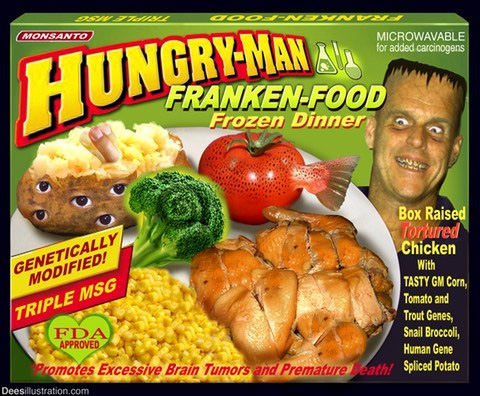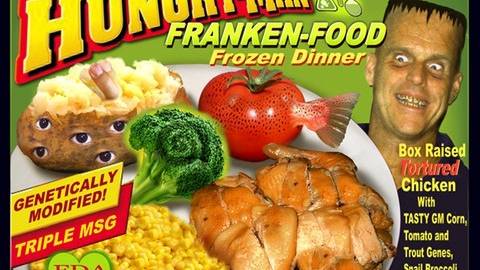Franken-Food Additives Poisoning the Masses

Did you know that many retired FDA officials go to work as special advisors to the pharmaceutical and food industries? Federal agencies like the FDA, which were created to protect consumers, often behave like branch offices of companies like Monsanto, which they are supposed to regulate. We should all know about the horror of Monsanto by now.
The FDA approved irradiated foods, which become radioactive as a result of processing. Dr. Gayle Eversole says, “Food irradiation exposes food to the equivalent of 30 million chest X-rays. Irradiation creates new chemicals in foods called radiolytic products. Some of these products are known cancer-causing substances (like benzene in irradiated beef). Others are unique to the irradiation process and no one knows what effects these have on human health. Irradiation destroys essential vitamins and nutrients that are naturally present in food. No studies have been done to show that a long-term diet of irradiated foods is safe. Safer, well-tested alternatives to irradiation exist.” Wow, what an amazing breakthrough FDA! You sure care about us and the environment. Yet they’ll go on hiding under the cloak of concern and safety for the public.
The FDA has no definition for “natural” used on food labels and continues to be extremely sinister and sneaky by labeling MSG under many obscure names. Why? These people are psychotic and want to poison the masses.
The European Food Safety Authority isn’t off the hook either. According to the candid confession of Dr. Herman Koeter, former EFSA director who resigned in 2008, the EFSA was about to announce to the world that aspartame is a deadly neurotoxin, unsafe for humans in any form. But eleven of the “experts” had connections with the aspartame industry. Somehow the evidence was “lost.” EFSA declared this chemical poison is safe as rain. Safe for babies, safe for children, safe for pregnant mothers, safe for diabetics, safe for everybody! Excellent work EFSA! You really care about what matters most.
This article is intended to bring awareness about dangerous food additives. Like in the 1985 movie Brazil, where everyone orders food according to a number, instead of saying what it is, it doesn’t seem so far off from food labeling today.
If you live in the European Union, you’ve probably noticed the letter E followed by a number on a label of a food item. This identifies food additives (e.g., sweeteners, preservatives, stabilizers). Additives receive an E number (E for Europe), simplifying communication about food additives in the list of ingredients across the different languages of the EU. E-numbers are also encountered on food labeling in other jurisdictions, including the Cooperation Council for the Arab States of the Gulf, Australia, New Zealand and Israel. They are increasingly, though still rarely, found on North American packaging, especially in Canada on imported European products.
It’s time to become a hawk reading food labels at the grocery store. Your physical body, mind and soul depend upon it.
If you live in the EU, you’ll see hundreds of different E-numbers. Most are toxic and will make you sick in time. Only eat from the following below, which come from natural sources. We’ll agree that the definition of natural is, produced by nature. (It was a shorter list to note the ok’s vs. the bad. For the USA list scroll down.)
of cancer
purposes from wood pulp; used in low-joule foods and carbohydratemodified sweets, icecream and jams
If you live in the USA, avoid these toxic additives, preservatives, sweeteners, flavor enhancers, firming agents, solvents and more.
Preservatives: (Found in fruit sauces and jellies, beverages, baked goods, cured meats, frozen fish, oils margarines, cereals, dressings, snack foods and fruits and vegetables)
sodium benzoate, benzoic acid, calcium propionate, sodium nitrite, sodium nitrate, BHA (butylated hydroxyanisole), BHT (butylated hydroxytoluene), EDTA (calcium disodium), TBHQ (tert-butylhydroquinone), sodium nitrite, propyl p-hydroxybenozoate, propylparaben, paraben, sulphur dioxide, sodium sulfite, sulfur dioxide
Sweeteners: (Found in beverages, baked goods, confections, sugar substitutes and many processed foods)
sucrose (note: sugar is needlessly added into everything these days), glucose, corn syrup, high fructose corn syrup, fructose, saccharin, aspartame, sucralose, acesulfame potassium, neotame
Color Additives: (Found in many processed foods, candies, snack foods, margarine, cheese, soft drinks, jams/jellies, gelatins, pudding and pie fillings)
FD&C Blue No. 1, FD&C Green No. 3, FD&C Red No. 3, FD&C Yellow Nos. 5 & 6 also known as tartrazine, Citrus Red No. 2, Sudan 1, stannous chloride (tin), (note: exempt color additives are not required to be declared by name on labels but may be declared simply as colorings or color added)
Flavors & Flavor Enhancers: (Found in pudding and pie fillings, gelatin dessert mixes, cake mixes, salad dressings, candies, soft drinks, ice cream, toppings, BBQ sauce, Asian sauces, popcorn butter and many processed foods)
artificial flavor, natural flavor (note: the FDA has no definition for “natural.”), monosodium glutamate (MSG), hydrolyzed vegetable protein (HVP), diacetyl, chloropropanols, disodium guanylate, nonyl alcohol, polysorbate 80 (also known as tween 80), potassium bromate, potassium nitrate (SaltPeter, also a component of gun powder), disodium guanylate or inosinate, seasoning
Fat Replacers: (Found in baked goods, dressings, frozen desserts, confections, cake and dessert mixes, dairy products)
modified food starch, olestra, olean, sucrose polyester
Emulsifiers: (Found in salad dressings, peanut butter, chocolate, margarine, frozen desserts and used to allow smooth mixing of ingredients, prevent separation, keep products stable, reduce stickiness, control crystallization, keep ingredients dispersed, and to help products dissolve more easily)
sorbitan monostearate, polysorbates, soy lecithin (note: much debate exists on the effects of soy, especially genetically modified soy)
Other: (firming agents, acid agents, strengtheners, shelf life enhancer, packaging, solvents)
aluminum, silicon/silica/ silicon dioxide, trans fat, potassium bromated, hexane used in margarine, milk protein concentrate (the dried leftovers of dairy processing from all over the world are mixed together and generically called MPC ), propylene glycol prevents discoloration, sodium acid pyrophosphate, calcium sulfate, fumaric acid, ammonium sulfate, xanthan gum (questionable GMO), azodicarbonmide, hydrogenated oil
“Everyone knows that some people get reactions after eating the food ingredient monosodium glutamate --reactions that include migraine headaches, upset stomach, fuzzy thinking, diarrhea, heart irregularities, asthma, and/or mood swings. What many don’t know, is that more than 40 different ingredients contain the chemical in monosodium glutamate (processed free glutamic acid) that causes these reactions. The following list of ingredients that contain processed free glutamic acid has been compiled over the last 20 years from consumers’ reports of adverse reactions and information provided by manufacturers and food technologists”- truthinlabeling.org
Monosodium glutamate (E 621)
Monopotassium glutamate (E 622)
Calcium glutamate (E 623)
Monoammoniumglutamate (E 624)
Magnesium glutamate (E 625)
Natriumglutamate
Yeast extract
Anything“hydrolyzed”
Any“hydrolyzed protein”
Calcium caseinate, Sodium caseinate
Yeast food, Yeast nutrient
Autolyzed yeast
Gelatin
Textured protein
Vetsin
Ajinomoto
Bouillon and broth
Stock
Whey protein
Whey protein concentrate
Whey protein isolate
Any“flavors” or “flavoring”
Maltodextrin
Anything“ultra-pasteurized”
Barley malt
Pectin (E 440)
Protease
Anything “enzyme modified”
Anything containing“enzymes”
Malt extract
Soy sauce
Soy sauce extract
Soy protein,
Soy protein concentrate
Soy protein isolate
Anything “protein fortified”
Anything “fermented”
Seasonings
Corn syrup
Modified food starch
Lipolyzed butter fat
Dextrose
Rice syrup
Brown rice syrup
Milk powder
Reduced fat milk (skim; 1%; 2%)
most things low fat or no fat
anything Enriched
anything Vitamin enriched
The project of compiling a list of toxic ingredients has been daunting, aggravating and extremely disappointing because we face the fact that we are being deliberately poisoned and lied to. None of these ingredients are necessary. Only psychotics (or aliens who have infiltrated our food industry in order to kill us off) deem them necessary. As Jack LaLanne said "If man made it, don’t eat it." I question if mankind is even behind this because these chemical processes are so alien. This must run deeper than greed and availability.
Since not every toxic food additive is contained on these lists, remember a general rule while reading food labels. If you don’t know what it is, don’t eat it and the fewer ingredients the better. Even then, we must do some digging to verify that the foods we buy have not been genetically modified, including soy, wheat germ, maize, cottonseed and rice. You can always write the food manufacturer and ask! Make a list of ingredients to avoid and carry it with you when you go grocery shopping.
Make a lifestyle change and eat real, organic, hormone free and GMO free food. Support local farmers and companies who distribute organic food. They need our support! If you eat meat, know your local butchers so you can ask questions about how the animals are treated. You can discover ways to mix and match and spice up your menu with ingredients Mother Earth has already provided.
More health articles






















